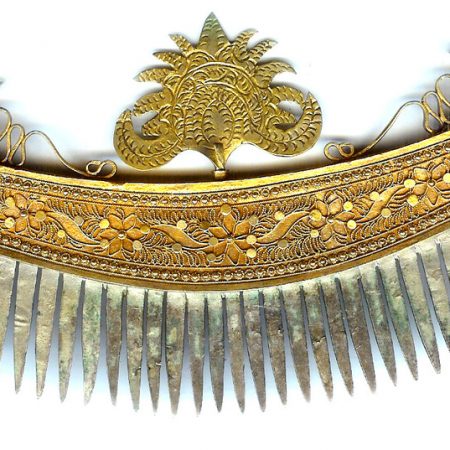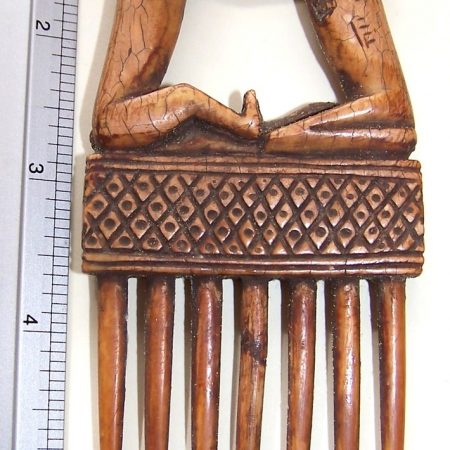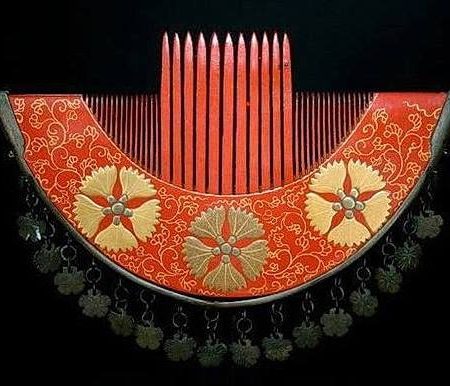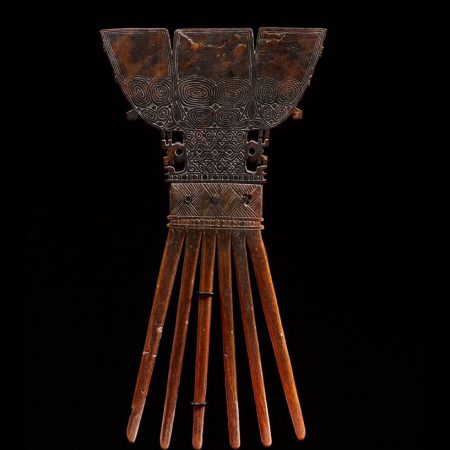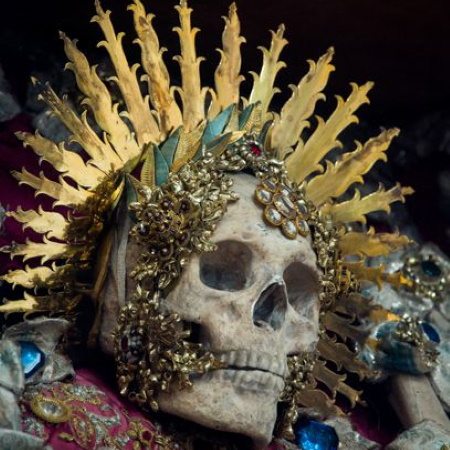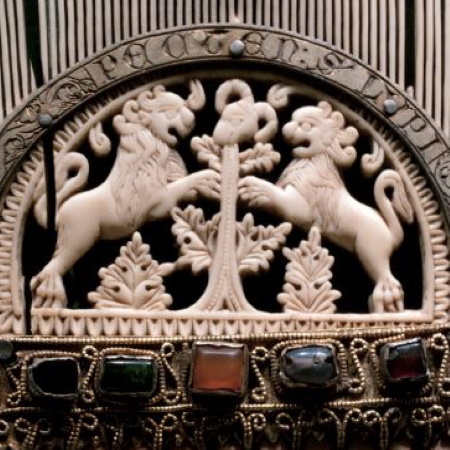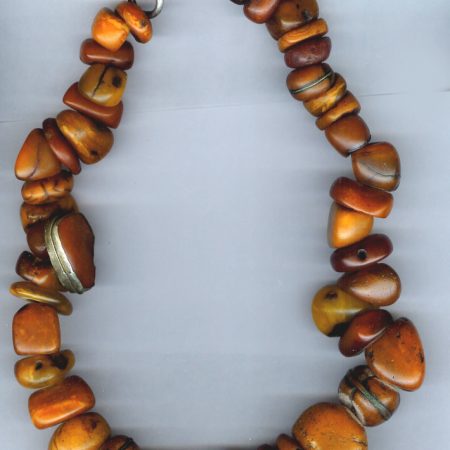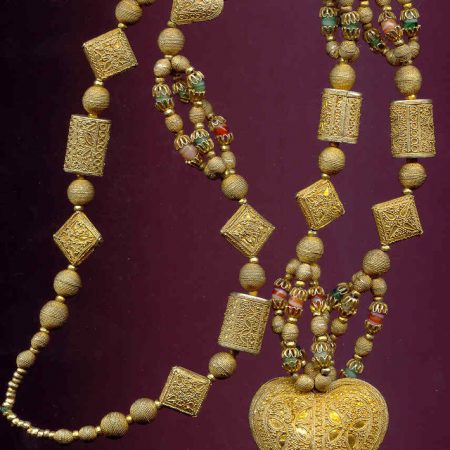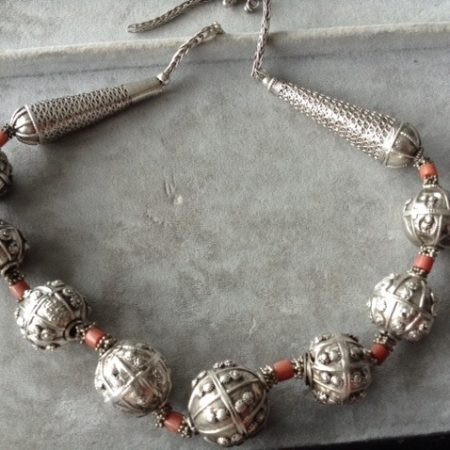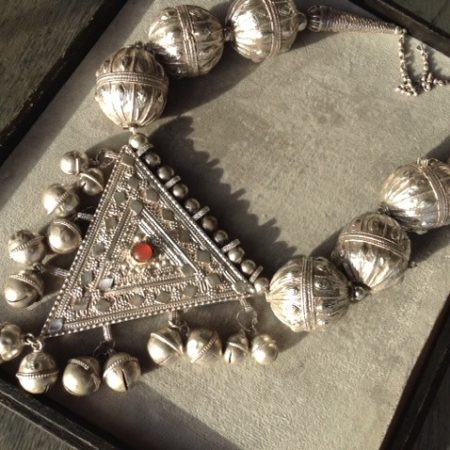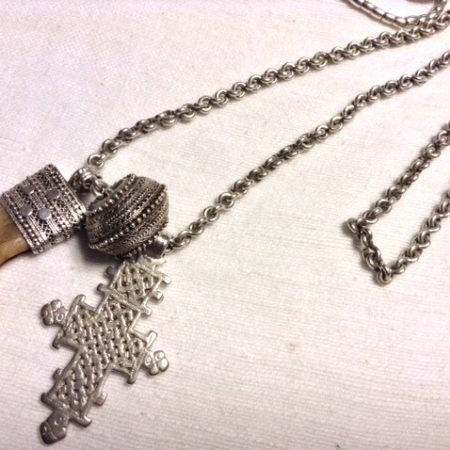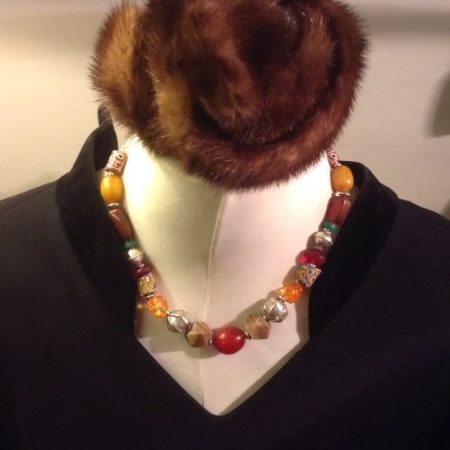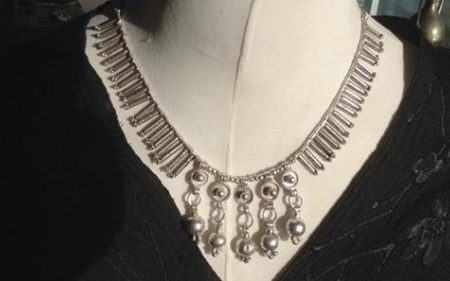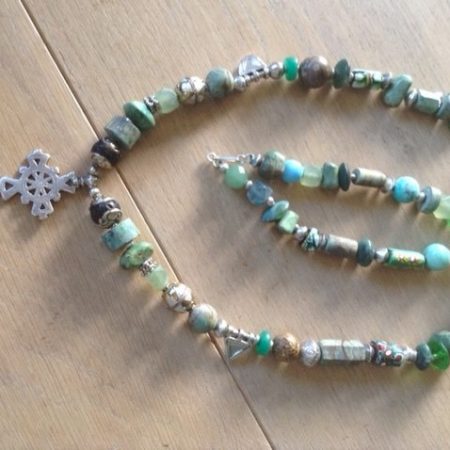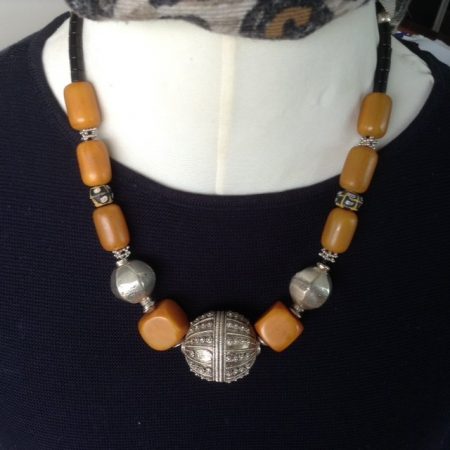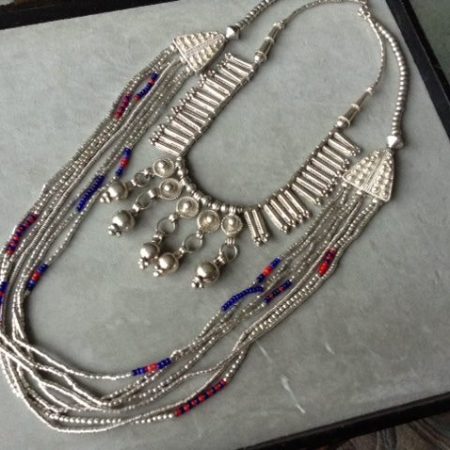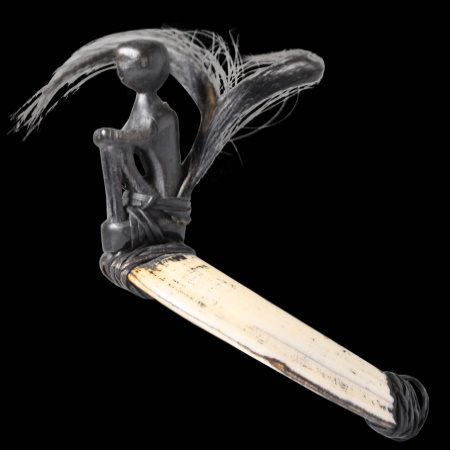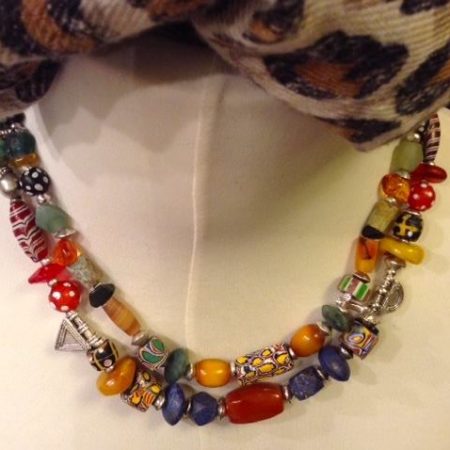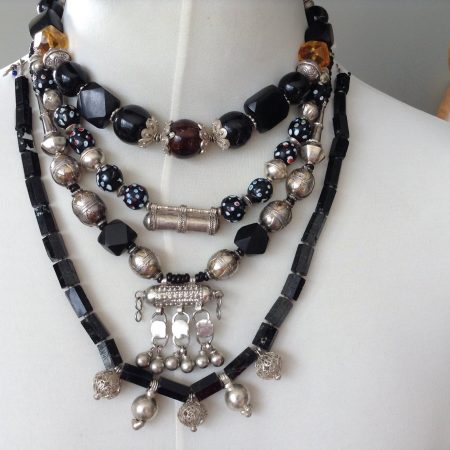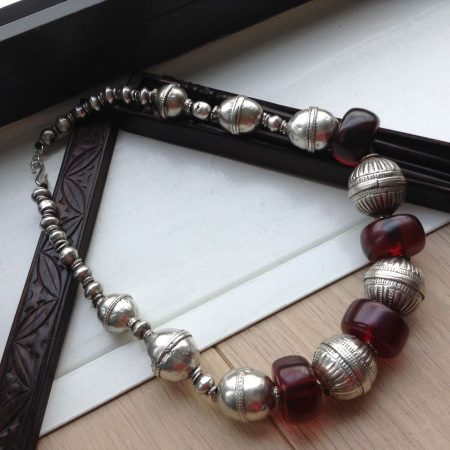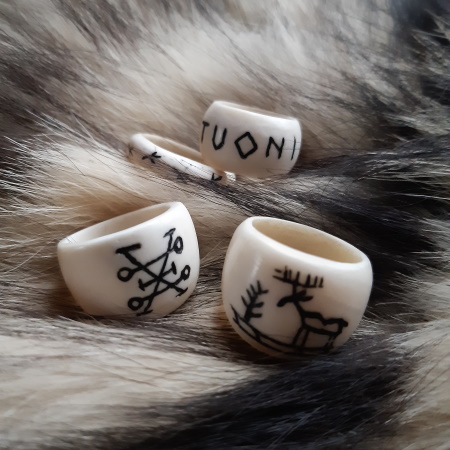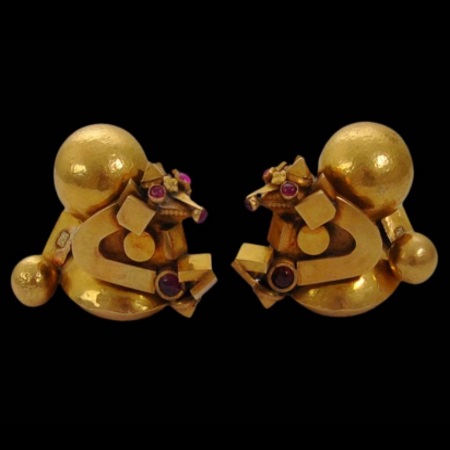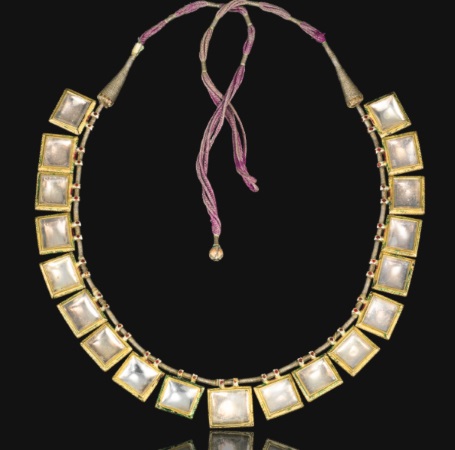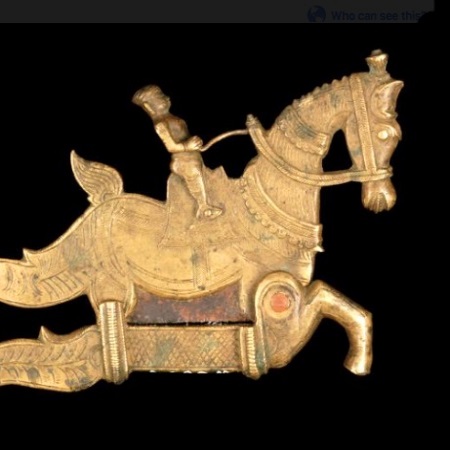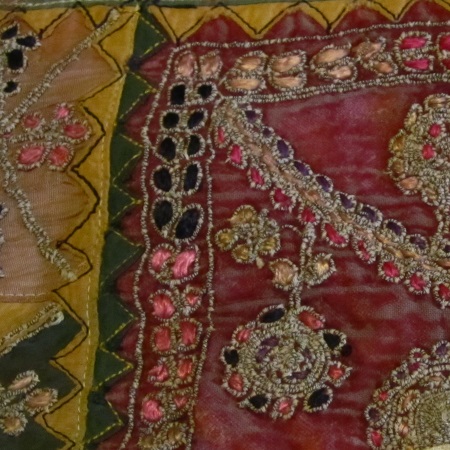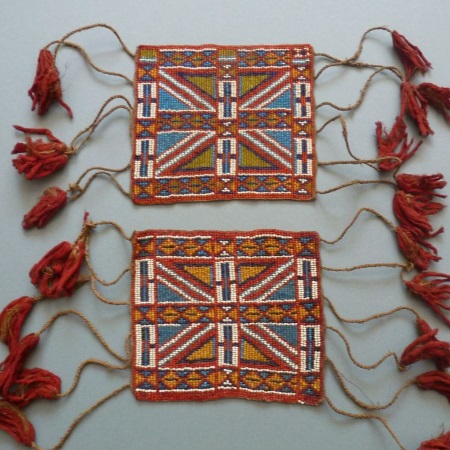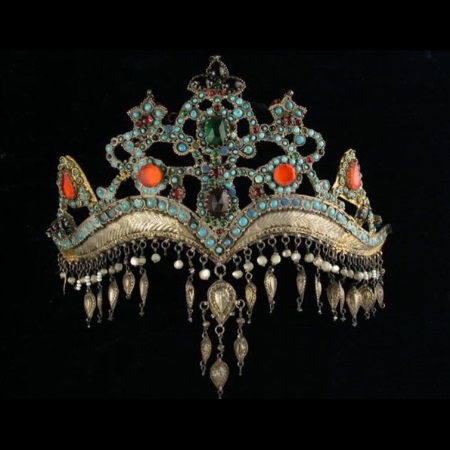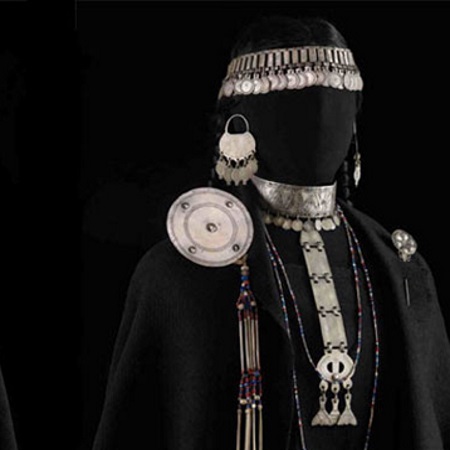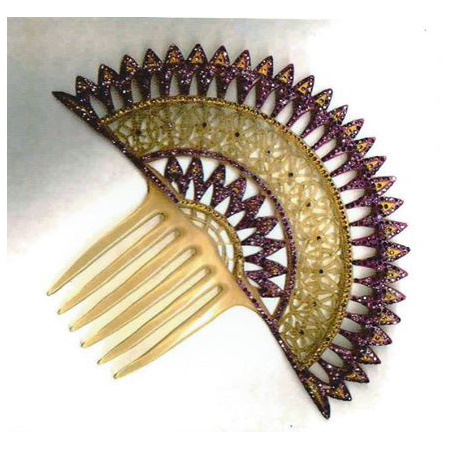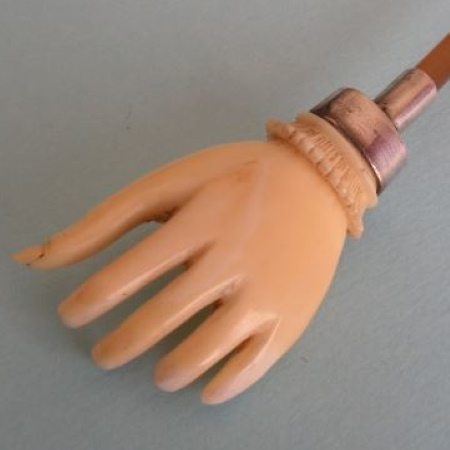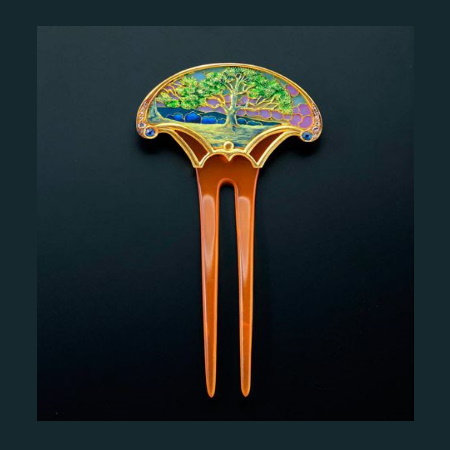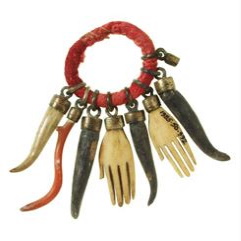Picture credit – Linda PastorinoPosted by – Linda Pastorino A hair comb made up of silver gilt with granulated and wire work surface of incredible detail for gilt, having 3D birds perching on top, has a mount. Late 19th Century, from Suluwesi, Indonesia. Click here to see the original post.
Archive Search results for: comb
Picture credit – Kathleen McCabe-ElseyPosted by – Kathleen McCabe-Elsey An Ashanti wooden comb, from Ghana. Click here to see the original post.
Photo credit – Cordelia DonohoePosted by – Cordelia Donohoe A gold washed, tortoise shell Sri Lankan hair comb. Late 19th – early 20th century. Click here to see original post.
Photo credit – Joost DaalderPosted by – Joost Daalder Japanese hair comb which dates back to the late Edo period (1603 – 1868) and is quite large. It is made of wood which has been beautifully painted (using lacquer and gilding). It has an attached rim made of silver, with silver tassels. Click here to … Continue reading “Hair comb – Japan”
Photo credit – Joost DaalderPosted by – Joost Daalder Ornamental lacquered comb from Lampung, south Sumatra, Indonesia. Materials: wood, silver alloy, lacquer, gilding. Likely early 20th century. Click here to see original post.
Photo Credit – Joost DaalderPosted by – Joost Daalder Man’s ceremonial decorative comb (“suar sair”), worn horizontally at the back of the head. Indonesia, Tanimbar, village of Alusikarwain; 19th c. Wood and bone. Click here to see original post.
Photo credit – Susan L. Beningson CollectionPosted by – Joost Daalder Ivory and gold comb with ruby knob (front) Karnataka, India. Late 18th century. Click here to see original post.
Photo credit : Joost DaalderPosted by : Joost Daalder Japanese hair comb from the early 19th century. Materials include tortoiseshell, black lacquer, Togidashi maki-e (clear lacquer). Click here to view original post
Photo credit : Allan Stone Collection, New YorkPosted by : Joost Daalder Comb from the lesser Sunda islands, Timur, Indonesia. Carved from turtle shell and buffalo horn and pinned together with old bronze or brass pegs. Early 20th century. Height: 6 in / 15.2 cm Click here to see original post
A comb from Tanimbar. Maluku Provence, Indonesia. By Truus Daalder. In my book Ethnic Jewellery and Adornment (Ethnic Art Press and Macmillan, 2009), I described and illustrated (p. 170) a very rare comb from Tanimbar, situated in the east of Indonesia, in the southern Moluccas (Maluku). I was unable to show there the only drawing … Continue reading “Tanimbar Comb”
By Sarah Corbett Between the 16th and 19th century, by order of the Vatican thousands of ancient Roman corpses were exhumed from the catacombs of Rome.These skeletal remains were given fictitious names and were sent abroad as relics of saints. Although it is unlikely that any of the corpses were of religious significance, the remains … Continue reading “Catacomb Saints”
Of Combs and Saints, by Barbara Steinberg It was a time before nations. Celtic tribes ruled Gaul until they were conquered by the Roman Empire (121 – 51 BC). In the early 5th Century, Roman Gaul was overwhelmed by the Visigoths, Burgundians, and Franks until 481, when Frankish King Childeric I defeated the Visigoths, and his … Continue reading “Combs and Saints”
Picture credit – Linda PastorinoPosted by – Linda Pastorino A heavily encrusted headdress with inlaid turquoise and coral, filigree wire work having gilt over silver combined with silver for contrast. From Uzbekistan. Click here to see the original post.
By Hala Munther Salem Introduction I was invited to an online Zoom meeting last week where Hala was giving a presentation about the textiles of her homeland. Hala lives in Gaza in Palenstine, and is 15 years old she is part of a project called the Hands up Project which works with children in Palestine … Continue reading “Palestinian Folk Embroidery”
Picture credit – Linda PastorinoPosted by – Linda Pastorino A necklace of contemporary composition, combining large Tibetan coral and amber beads with Himachel Pradesh and Tiznit enamelled silver on antique dori string. Click here to see the original post.
Picture credit – Linda PastorinoPosted by – Linda Pastorino A necklace combining a collection of Tibetan amber beads and antique clasp. Click here to see the original post.
Picture credit – Dr. SpeckPosted by – Dr. Speck This necklace is made of a large Venetian Chevron bead combined with a multi strand of antique handmade brown Venetian glass seed beads. Click here to see the original post.
Picture credit – Annemarie KoglerPosted by – Annemarie Kogler A necklace from Senegal, dated in the 1930’s. Made up of intricate silver-gold beads combined with little Bohemian glass beads. Click here to see the original post.
Picture credit – Ingrid LangerakPosted by – Ingrid Langerak A large silver necklace combined with small coral beads, from Yemen. Click here to see the original post.
Picture credit – Ingrid LangerakPosted by – Ingrid Langerak A large silver necklace, from Yemen; a combination of old and new work. The large wedding balls are old and the pendant is new work. The typical Turkoman influence décor, which can also be found on Ethiopian pieces. Click here to see the original post.
Picture credit – Ingrid LangerakPosted by – Ingrid Langerak An weighty silver linked chain, weighty, with different pendants, inlcuding a protective Bobcat claw set in silver. This is a protective symbol worn by a pregnant woman to protect the unborn baby. Combined with a refined filigree wedding neck-ring from Tigrai/Eritrea, and a silver Axum design … Continue reading “Necklace – Ethiopia/Eritrea”
Picture credit – Ingrid LangerakPosted by – Ingrid Langerak Ethiopian/Eritrean antique Telsums (charms) in silver, combined with phenolic resin and Czech seed beads and handmade silver cone beads. Click here to see the original post.
Picture credit – Ingrid LangerakPosted by – Ingrid Langerak A necklace of contemporary composition, made up of a combination of Faturan Resin, Bakelite beads, combined with Italian Murano glass beads, otherwise known as feather beads, skunk -eye beads in red black and white. These are complimented with Ethiopian silver beads and silver telsums-charms. Click here … Continue reading “Necklace – Ethiopia”
Photo credit – Sarah CorbettPosted by – Sarah Corbett Necklace created by jewellery designer Faouzi M’ghete, in Morocco. A combination of old elements have been used to create this fantasy piece. Pieces used include coral beads, tassels and small temporal rings. Click here to see original post.
Photo credit – Sarah CorbettPosted by – Sarah Corbett Necklace created by jewellery designer Faouzi M’ghete, in Morocco. A combination of old elements have been used to create this fantasy piece. Including coral beads, foiled glass & silver pendants. Click here to see original post.
Photo credit – Sarah Corbett Posted by – Sarah Corbett Necklace created by jewellery designer Faouzi M’ghete, in Morocco. A combination of old elements have been used to create this fantasy piece. Including coral beads, amber & silver pendants. Click here to see original post.
Picture credit – Ingrid LangerakPosted by – Ingrid Langerak A necklace of contemporary composition, made up of a silver Yemeni Bawsani marked Dowry beads and Naria Theresa Thaler Pendant, combined with Ghanaian Wood/Bone beads, antique Amsterdam Blue glass beads, and strung together with Ethiopian good silver anklet beads. The back part is done with natural … Continue reading “Necklace – Yemen”
Picture credit – Ingrid LangerakPosted by – Ingrid Langerak A firm necklace made up of good silver. Yemeni beads in combination with an Ethiopian silver earspoon pendant. Click here to see the original post.
Picture credit – Ingrid LangerakPosted by – Ingrid Langerak A colourful necklace of contemporary composition, made up of a combination of glass trade beads, resin, carnelian and silver beads, from Ethiopia. Click here to see the original post.
Picture credit – Ingrid LangerakPosted by – Ingrid Langerak A necklace of contemporary composition. A combination of Yemen pendant, Ethiopian/Yemen resin beads and Italian Murano glass trade beads. Click here to see the original post.
Picture credit – Ingrid LangerakPosted by – Ingrid Langerak An Eritrean/Ethiopian fertility symbol necklace. Combination Eritrean anklet beads and Argobba fertility symbols. Click here to see the original post.
Picture credit – Ingrid LangerakPosted by – Ingrid Langerak A long necklace, combination of unpolished turquoise and Ethiopian silver coptic cross pendant, telsums and beads. Click here to see the original post.
Picture credit – Ingrid LangerakPosted by – Ingrid Langerak A necklace made up of a combination of Ethiopian antique telsums (protective charms) with newly made( 1990) centre and side pieces. All are good silver, strung with Asian Sterling silver beads. Click here to see the original post.
Picture credit – Ingrid LangerakPosted by – Ingrid Langerak A necklace of contemporary composition of silver from the Wollo region of Ethiopia, combined with glass trade beads. Click here to see the original post.
Picture credit – Ingrid LangerakPosted by – Ingrid Langerak A necklace of contemporary composition made up of silver telsums (charms) from Ethiopia/Eritrea, and fertility symbols combined with glass trade beads. Click here to see the original post.
Picture credit – Ingrid LangerakPosted by – Ingrid Langerak A necklace of contemporary composition, made up of silver Eritrean fertility symbol anklet beads, combined with hematite beads. Click here to see the original post.
Picture credit – Ingrid LangerakPosted by – Ingrid Langerak A necklace of contemporary composition made up of silver, Eritrean fertility symbol anklet beads, in combination with coloured glass trade beads. Click here to see the original post.
Picture credit – Ingrid LangerakPosted by – Ingrid Langerak A necklace made up of a combination of Eritrean fertility anklet beads and a small Ethiopian prayer box, with telsum (charms). All made of good silver. Click here to see the original post.
Picture credit – Ingrid LangerakPosted by – Ingrid Langerak Eritrean/Ethiopian combination of good silver fertility symbols . The main beads are original Eritrean anklet beads combined with Argobba bells. Click here to see the original post.
Picture credit – Ingrid LangerakPosted by – Ingrid Langerak A necklace of contemporary composition, made up of silver Yemeni Wedding pendants combined with black coral, blue lapis lazulli and black /blue Bohemian glass beads. Click here to see the original post.
Picture credit – Ingrid LangerakPosted by – Ingrid Langerak A necklace of contemporary composition, made up of silver Ethiopian Jimma/Kaffa beads, combined with blue Tjechian seed beads. Click here to see the original post.
Picture credit – Ingrid LangerakPosted by – Ingrid Langerak A necklace of contemporary composition, made up of Yemen silver granulate bead with the Bawsani mark plate on it, combined with old resin, amber beads, and two old Italian black eye beads. Click here to see the original post.
Picture credit – Ingrid LangerakPosted by – Ingrid Langerak A Bronze Ethiopian Coptic priest’s hand cross, made in the lost wax system. Decorated in a combination of Lalibella(birds) and the Gondar angles. The wooden drinking cup is a church cup with the Gondar Angels as decoration. Click here to see the original post.
Photo credit – Ingrid LangerakPosted by – Ingrid Langerak Ethiopian Harar/Harargue Murias wedding necklaces. These are originals: note: not a combination of different necklaces. They mostly exist of 13 pieces in these decorations. Done in good silver, or sometimes in gold often by the Afar people. Click here to see original post.
Photo credit – Ingrid LangerakPosted by – Ingrid Langerak North Ethiopia/Tigrai and Eritrean Traditional wedding pendants. 18Kt gold, hand made, the real thing received in 1963 and 1978. Very refined filigree work. These pendants are mostly gifts to the bride by friends or Groom. They can come in different combinations, like one ring and 2 … Continue reading “Necklace – Ethiopia”
Picture credit – Ingrid LangerakPosted by – Ingrid Langerak Two necklaces of contemporary composition. The outer necklace is made up of silver Ethiopian/Eritrean Jimma/Kaffa beads. The inside one is a combination of Eritrean fertility symbol anklet made into a necklace combined with Argobba pendant. Click here to see the original post.
The Bontoc/Ifuago inhabit the southern Cordillera Central region in the rugged highlands of Northern Luzon, this region comprises some of the highest mountains in the Philippines. The area is historically home to many headhunting tribes.There are approximately 60 ethnic groups and 70 languages in this region. The Bontoc create bracelets called Baningal or Abkil from … Continue reading “Baningal – Northern Luzon”
Picture credit – Ingrid LangerakPosted by – Ingrid Langerak A necklace of contemporary composition, made up of old trade beads, glass and semi precious stones, combined with silver Ethiopian beads and amulets, such as telsums and fertility symbols. Click here to see the original post.
Picture credit – Ingrid LangerakPosted by – Ingrid Langerak A necklace of contemporary composition, with black jet beads, unpolished turquoise and tourmaline, (all from Afghanistan). French faux jet (glass) and Tjechian glass, combined with silver beads. Click here to see the original post.
Picture credit – Ingrid LangerakPosted by – Ingrid Langerak A collection of necklaces of contemporary composition, made up of large black coral , Afghan jet and topaz, antique Italian black eye (skunk) beads, rough cut dark green tourmaline; all combined with silver pieces from Ethiopia and Afghanistan. Click here to see the original post.
Picture credit – Ingrid LangerakPosted by – Ingrid Langerak A collection of Ethiopian necklaces, made with a combination of black glass beads, french old glass jet beads, bone and silver protective amulets (telsums), and fertility beads. Click here to see the original post.
Picture credit – Ingrid LangerakPosted by – Ingrid Langerak Necklace of Ethiopian rare collectable beads, antique german bakelite beads, worn in Ethiopia as protection with certain ethnic groups, combined with silver beads from the Oggadin,Ethiopia/Somalia, and antique Masbaha silver prayer beads. Contemporary composition. Click here to see the original post.
Riikka Palonen . No waste! Agriculture and animal husbandry moved to the area now known as Finland relatively late, around 2800-2500 BC. Finns were a hunting nation – or we still are: hunting is an integral part of rural life, and today women also take an active part in wilderness. As a trade, hunting is … Continue reading “Riikka Palonen the Bonemaiden”
Splendour and Shine in the River of TimeReview by Sarah Corbett 2020Irene SteinerISBN 978-3-9524770-8-3Liechtensteiniches Landes Museum For those who enjoy the material culture of the people of the world, this catalaogu of the exhibits of an exhibition in the Liechtensteiniches Landes Museum is a feast for the senses. As I scanned the pages for the … Continue reading “Book Review”
The World of the Moche, by Barbara Steinberg. On the North Coast of Peru, a line of extreme environments begins with the Pacific Ocean, is edged by a sandy strip of desert, and continues toward the Peruvian Andes’ towering snow-capped mountains. Some have an altitude of 22,000 feet, while the Equator lies below. Traveling east, … Continue reading “Moche”
By Sarah Corbett Henna cloth is a deeply symbolic form of textile art which was historically made and worn by the women of Southern Morocco. The pieces vary in size and in function,but were locally woven natural fibre pieces which were adorned with henna. Henna is grown in Morocco and is believed to have many … Continue reading “Henna Cloth”
By Barbara Ann Steinberg Pambadam earrings combine traditional female customs in Tamil Nadu with the northern Krishna-cult story of the Naga Kaliya. The earring is a stylized cobra coiled on her nest. She is laying eggs, which are expressed as a large ball connected to a smaller one on the back. The arch-shaped pieces on … Continue reading “Pambadam Earrings”
Kundan Mina Work in Jaipur by Barbara Steinberg An Indian necklace commands presence by magnificent jewels set in pure gold, known as a Kundan setting. Before mirrors were invented, a woman could not see the front of her necklace when she wore it. The brilliance of her gems lay in the eyes of admirers. However, … Continue reading “Kundan Mina”
by Barbara Steinberg Narcotics cover the world and time. Some have become licit, as they accessorize common ceremonies and social interactions. In tropical South Asia, the Areca Catechu palm tree fruits the betel nut and only grows near the sea. [1]. They include a variety of alkaloids, including arecoline, which can bring a sense of … Continue reading “The Betel Nut”
I collect antique textiles, primarily Islamic, –embroidery, tapestry, weaving, quilting — as opposed to carpets which are not only more expensive but more susceptible to counterfeiting and false aging. These cloths were primarily made for home use as clothing, hangings, floor covers, table cloths, animal covers– Most are tribal but some, such as ikats, were … Continue reading “Collector – Patti Deany”
by Sarah Corbett The ‘deel’ is an item of Mongolian traditional clothing. A unisex item, which is still worn outside the major towns and cities. The ‘deel’ is not unique to Mongolia, and may also be seen worn by nomadic tribes of Central Asia. The garment is generally calf length and is fastened by clasps … Continue reading “Mongolian clothing”
An example of Beadwork from Oceana circa 1020 by Truus Daalder When my husband Joost and I had reached the cut-off point for including items in my book Ethnic Jewellery and Adornment (Ethnic Art Press and Macmillan, 2009: see link www.ethnicartpress.com.au), our collecting habits did not change, and they still have not. Our interest in ethnic jewellery … Continue reading “Oceanic Beadwork”
Bridal forehead decoration There existed in the 19th century in Bukhara the largest and finest collective of Islamic Artists and craftsmen. The region around Bukhara has been inhabited for at least five millennia, and the city has existed for half that time. Located on the Silk Road the city has long been a center of trade, … Continue reading “Tillya Kosh”
Tibetan Ornaments worn on the belt or attached to clothes by Truus Daalder Many ornaments were sewn onto the clothes of Tibetan nomads by means of lugs, as protective amulets and functional items for easy use during their travels. This can be seen, for example, in the concave ornament which is adorned with small pieces … Continue reading “Tibetan Ornaments”
Mapuche Traditional Adornment by Leonor Arno Mapuche ethnic adornment is the great unknown for lovers of ethnic jewelry. Being a silversmith work without major technical challenges, it has great aesthetic strength for the simplicity of its shapes and the great originality of its designs. The Mapuche people live on the Andes Mountains, straddling Argentina and … Continue reading “Mapuche”
by Sarah Corbett The attire of a Tuareg woman of the African Sahara consists of a large rectangular piece of fabric. The fabric, also known as Mellhafa is held in place in the billowing winds of the Sahara by a very particular and unique piece of jewellery. The Asrou n swoul, meaning the key which … Continue reading “Asrou n swoul”
The Congo, by Barbara Steinberg The Luba Empire was a pre-colonial Central African state, which was founded by King Kongolo Maniema, c. 1585. The Hemba people were incorporated because they started to migrate into Luba territory at the beginning of the Empire. In addition to being artistically influenced by the Luba, the Hemba endured kidnappings … Continue reading “Heart of Darkness”
Stanley Hill, SR., and Seneca Iroquois combs by Kajetan Fiedorowicz Many contemporary tribal artists reach to their nations’ historical sources for inspiration, which provides for a certain continuation of tradition. However, they do not always admit that reference. This makes the process of “joining stylistic dots” much harder, but not impossible. The comb presented below, … Continue reading “Seneca Iroquois”
by Sarah Corbett In 1699 Guru Gobind Singh, the 10th Guru of Sikhism, created the Khalsa Panth at Anandpur Sahib. This occasion transformed Sikhs into a family of soldier saints. During the transformative festival Guru Gobind Singh came out of a tent holding a sword, and challenged any Sikh who was prepared to give his life … Continue reading “Kara and Kirpan”
by Barbara Steinberg Many women practice their art secretly. Emily Dickinson had fewer than 12 poems published in her lifetime until her sister Lavinia discovered 1800 of them in a locked chest after she died. Jane Austen was first published anonymously.Collecting is also an art. To do it well, you must have an encyclopedic knowledge … Continue reading “Frances Wright”
A war against vermin by Jen Cruise This object may be unfamiliar to most people – it is a head scratcher or scratching stick (gratoir) and typical examples are shown in the accompanying pictures. I have known about their existence for a long time and occasionally seen them for sale, always expensive. They are referred … Continue reading “Headscratchers”
By Barbara Ann Steinberg Art Nouveau’s main ingredients were the Symbolists, who believed that art should reflect the truth indirectly as if in a dream; the flat perspective and strong colors of Japanese wood block prints; and Japanese organic forms and representations of nature. Out came the curvilinear forms of Art Nouveau, which lasted only … Continue reading “Symbolists”
By Leonor Arno The charm box pendant called the ga’u originated in Tibet. This sort of jewellery is in wide use throughout the western and eastern sub-Himalayan area by tribes who follow Buddhism and others who emulate them, though the local term used to designate it varies with the group. The origin of the charm … Continue reading “Tibetan Gau”
By Sarah Corbett The collection of the General Pitt Rivers, a 19th century soldier and scholar is a wonderful sensory onslaught. His thirst to discover and to develop his understanding of human development oozes from a plethora of cabinets. The organizational system is an arrangement which tells us something of the quests and concepts which … Continue reading “Pitt Rivers Museum”
By Alaa Eddine Sagid Celebrated as the main cultural project of former French president Jacques Chirac, it eventuallyconfirmed the prominent role claimed by Paris as the world capital for indigenous arts, cultures and civilizations from Africa, Asia, Oceania and the Americas.In fact one week earlier a local sale set a world record for any “primitive … Continue reading “The Quai Branly”
By Sarah Corbett Many of the exquisite ensembles of North African jewellery include handmade silver beads.The Jewish silversmiths of Southern Morocco were famed for their exceptional workmanship. The Jewish Berber population lived in Morocco from around the 1st century AD when the Jewish peoples expanded from ancient territories in Modern day Libya into the Southern … Continue reading “Beads of Southern Morocco.”
